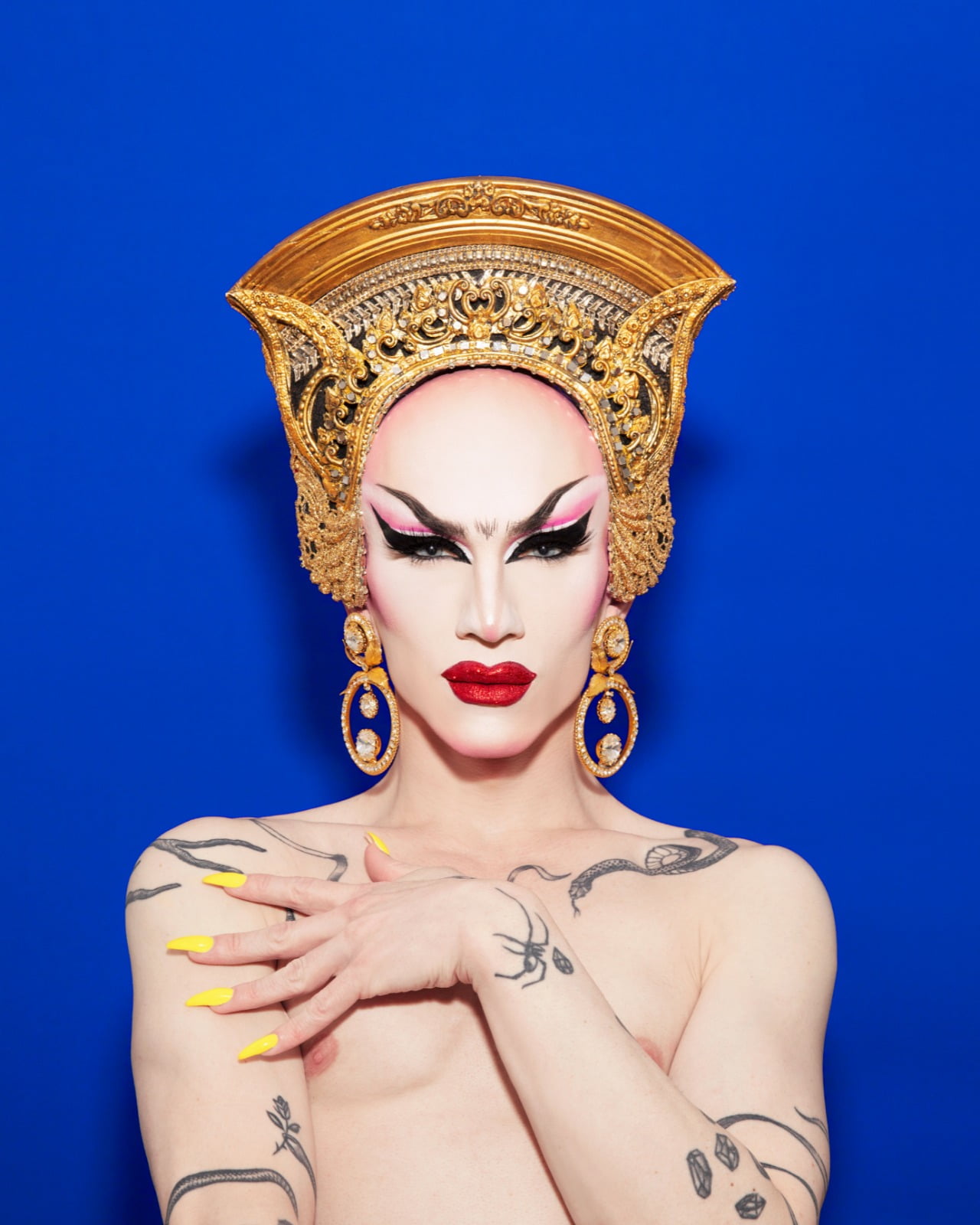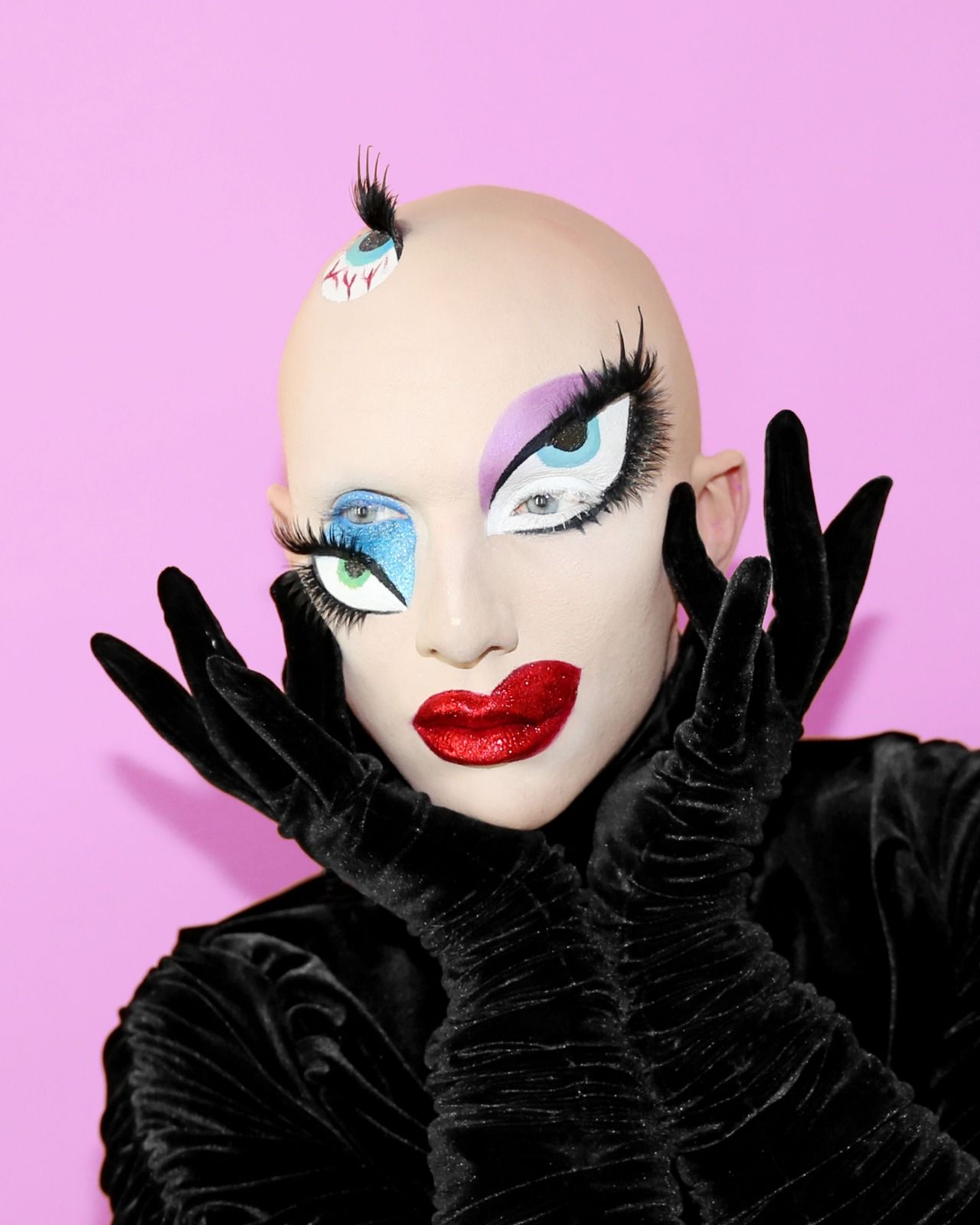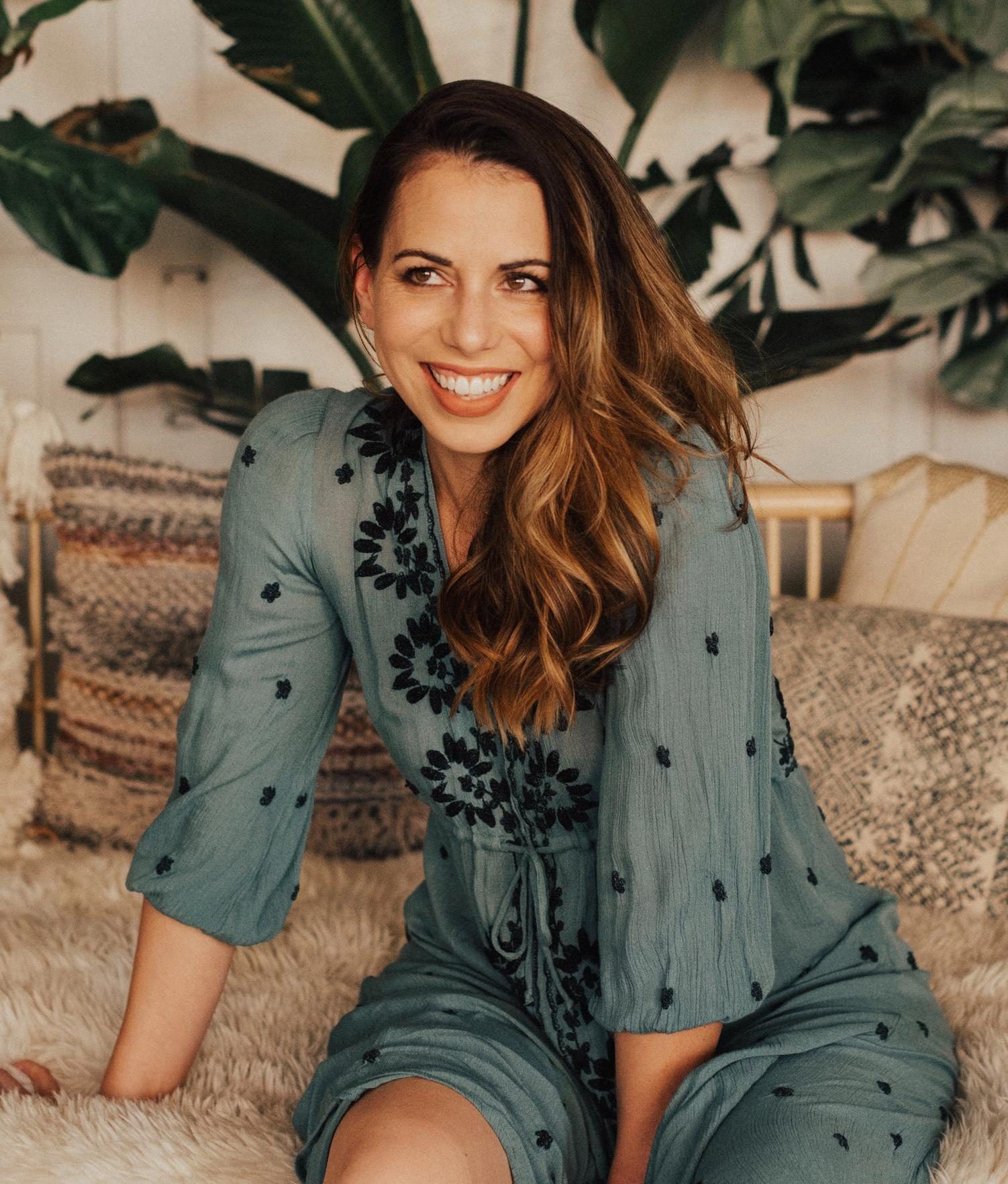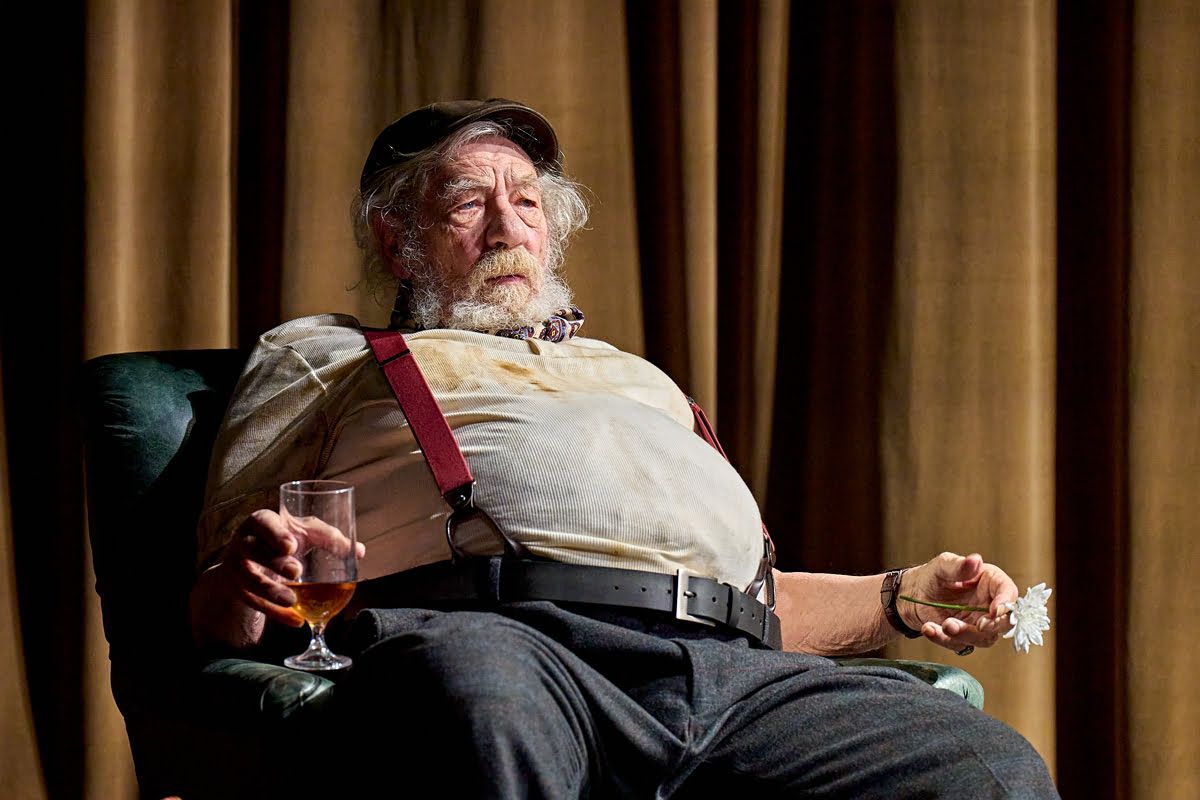
Sasha Velour
Sasha Velour, with a long list of achievements under her belt, can now add another. The newly minted author has just released her debut book, The Big Reveal: An Illustrated Manifesto Of Drag, just released here in the UK.
Step into the enchanting world of Sasha Velour, where glamour, talent, and charisma collide spectacularly – A kaleidoscope of creativity, Sasha makes up her own rules when it comes to her artistry and you can now sit yourself down in a comfy chair and be immersed in it. The Big Reveal: An Illustrated Manifesto Of Drag is a part-biographical part-historical collection piecing together and illustrating the art of drag. It’s a book that will inspire and educate people in the unique expression of drag as it tells the story of Sasha’s journey to where she is currently, recounting the women who raised her, learning her craft as an artist, and the history of queer life around the world which made it all possible. Surfing through success, disaster and much more, the book is a must-read for anyone and everyone.
You may best know Sasha Velour as the winner of RuPaul’s Drag Race season 9 back in 2017. From the first episode, it was clear to see there was something special about the all-around performer. showcasing a wealth of knowledge in fashion, art, and culture, she spent the season proving herself as the queen she is. Sasha’s lip sync to Whitney Houston’s So Emotional in the final has been hailed as one of the most iconic lip syncs the show has ever seen. Removing one glove after the other to allow a flurry of rose petals to fall to the floor before finally taking off her wig revealing even more, enabled her to walk away with the crown.
From there she has gone from strength to strength. Her show Nightgowns was founded in 2015 and has just taken up residence in New York’s iconic Le Poisson Rouge. Hosting some of the world’s greatest Drag Queens with new guest stars each month, in 2020 the show was adapted into a docu-series which met with high critical acclaim. Sasha now has more plans to take the show even further with a world tour being the plan.
Born in California, Sasha is also an accomplished visual artist and graphic designer, moving to New York with her partner Johnny Velour back in 2013 where she began creating and self-publishing comics and zines to sell at conventions. In the summer of 2014, she founded Velour, The Drag Magazine (previously entitled Vym) with Johnny, running for three issues which were then compiled into a hardback book in 2018. Her solo theatre show, Smoke & Mirrors premiered in Australia in 2019 followed by a seven-city tour of Australia and New Zealand before taking it to the US and the UK which mostly sold-out.
Sasha Velour is truly thought by many to be a real, refreshingly unique asset to the world of drag doing far more than just her bit in improving its education in a world where people are still fearful, sometimes suspicious and unsure. Being praised for her creativity, intellect, and emotional performances, Sasha often incorporates personal experiences and political messages into her shows, addressing topics such as queer identity, love, loss, and the power of self-expression. She continues to solidify her imprint as a prominent figure for the drag community, inspiring and extending boundaries in the world of performance art.
1883 Magazine’s Gabi Oates spoke to Sasha Velour about The Big Reveal, how her artistry has evolved since RuPaul’s Drag Race, and her hopes for the future of the art.

Sasha! Thanks so much for taking the time to speak with 1883 Magazine, how are you feeling now your debut book is out in the world? It has already received such wonderful reviews…
Thank you! It’s exciting because I didn’t know if I had it in me to write a book. I had lots of thoughts and stories I wanted to tell; stories from history and from my own life, so I’m relieved that I finished it and it’s out in the world so people can enjoy it and share those stories even further.
I heard it was three years in the making!
Yeah, it was really hard to write a book because I’m used to saying things in metaphors with costumes and a three-minute performance! – holding myself accountable to write it down was challenging, but a good challenge.
You have described it as “The book about drag that I always wanted to read but didn’t exist” I’m interested to know, in the time between first having thoughts of writing a book and actually putting pen to paper so to speak, what made you think “I want to do this… I could do this… I should do this”?
I guess I always had a reputation for bringing the history and philosophy of drag into the bar and then to the TV with drag race. Some people thought it was silly to always refer to history and to the bigger context, but to me, it was really essential, because there is, as we’ve seen, so much misunderstanding, about drag and about the nature of the community that has created a space for this art. I felt like these stories were essential and that there was a lot of misunderstanding the stories could help clear up.
I do somewhat have a background in writing from way back when. Before I was really doing drag I was making comics about the history of drag so I’ve kind of always been trying to try to combine entertainment and history into one project. I feel like this book is a good example of that. I have also already been turning the book into a show because it doesn’t feel complete to me until it’s on stage with reveals and some drag bringing it to life. It has felt very full circle to celebrate the book with performance.
That is definitely the most Sasha Velour way to do it!
[Laughs] Thank you!
By the sounds of it, you always planned for it to be part biographical, part historical…
Yeah definitely. There aren’t very many personal stories which are part of the history. The history is missing because of the nature of institutional records, a lot of the facts come from police records of arrests or newspaper articles which use offensive terminology so trying to find the humanity in our history is hard. I feel like being able to mix my own personal story in there, which I know to be fact, brings in joy, the joy that sometimes isn’t there when you try to capture the story.
The Big Reveal is a history of drag. It’s a journey through the survival of LGBTQIA+ people and your experiences growing up as a queer artist. It’s also an ode to femme icons from throughout your life including your mother and grandmothers. What do you hope people can take away from it? Do you wish it to become somewhat of a manual for young people to look upon and guide them on their journey, telling them ‘It’s okay’?
Exactly. I try to be everything for everyone which is an impossible challenge, I know, but I think for young people, drag and this book, need to be something that gives a sense of possibility and of normalcy. Even for people established in their lives, I think drag and also this book can be a reminder to maybe cast back to a time in our lives when we were a little more chaotic, free, and full of joy. It should be a reminder to tap into that child within us who loves to dress up and make-believe.
I also tried to write it so people who are not sure about drag, who worry that maybe it’s offensive or shocking – show and explain to them first of all, it can be those things – the world is full of those things that wouldn’t be so strange but also, fundamentally, it’s a really positive force that brings people together, exchanges resources for people who need it, and gives a sense of hope and strength in a world that doesn’t always open that up for everyone.
You have been using your platform to showcase artists since 2015 in the form of your Nightgowns show which has just taken up residence at New York’s historic downtown music venue, Le Poisson Rouge. The show features new guest stars and performances each month showcasing drag’s real broad potential. In 2020, the show was also adapted into a critically acclaimed docs-series, something you had been trying to make happen for a long time. How important is it for you to be able to use your platform to give other kings and queens a spotlight?
It’s been a really big joy for me to use the attention I got from appearing on drag race, which was like five years ago or more now. To still have these massively sold-out shows, not just in New York, but when I take my show on the road there’s always a huge audience. I’ve been able to have a really successful stage life because of being on TV and at every turn, trying to expand and surprise people’s ideas about what drag is like in real life.
I think a real drag show true to spirit is surprising and surprisingly good, even to fans of RuPaul’s Drag Race who’ve seen every episode.
First of all, we have types of drag that have not been featured on TV. Even just the nature of putting together a number that comes from your heart and creating the costume with time, workshopping it, and bringing it up on stage, you don’t really get to see that level of their art on TV. It gets a little lost in the joy of all the ridiculous challenges and the runway themes. So really, getting to see people pursue their own artistry in their own message on stage is so exciting.
Also, gender expressions and drag that go beyond the most obvious are I think really empowering for all people to see because you see drag as a place of freedom and you start to say “Okay, maybe my body and my life and the world could be a place of freedom with gender and look how exciting and gorgeous it is!”
Back in 2015 when you first started the Nightgowns show, what were your initial hopes for it? What was the idea behind it?
At the time, there weren’t a lot of gender-inclusive drag shows in New York City – or anywhere – so I wanted to have a mixture of kings, queens, beauty queens, and art queens. I’ve slowly learned that none of us actually think of ourselves in those terms but being given platforms where you’re not expected to show up as any particular kind of drag artist, you are just expected to do what you love as well as you can, is really liberating.
I wanted to make a space where the audience would pay attention, where you can bring whatever kind of performance you’re passionate about and there wasn’t any pressure on it being high-energy, or getting a lot of tips in a number and also, that there was freedom for gender and style.
That really was the goal and now I feel a lot more drag shows are like that, which I love. I do take a little tiny bit of credit for having shifted people’s expectations in that way. Now, it is so much about having a really simple but strong production quality that highlights drag.
I think a lot of shows think good production for drag shows is lots of flashing lights but we’re kind of the opposite of that. I believe in having some beautiful colours that complement the costume, a gorgeous visual that makes sense, and let the simplicity of drags ability to tell stories shine.
Drag has been on a well-deserved steady incline for a long time but sadly, we still have a way to go in its understanding. With America currently fighting against anti-drag and anti-trans legislation being put in place all over the country, it’s easy to become disheartened with its progress. It’s hard to believe we live in a world where these staggering ideals are agreed upon by so many people but very clear we need to continue to push education. What do you have to say to the people making and backing these types of devastating bills? What do you think can be done to help people understand that drag is an art of freedom, it’s not something to be afraid of?
I think we have to show drag to all people. It’s the thing they’re most afraid of and perhaps that’s because they know if people really saw drag, they would be inspired by it, not scandalised or groomed in any way but liberated to be themselves.
All kinds of people come to drag shows, it’s mostly adults of course – there isn’t a huge problem with kids at drag shows, that’s made up – but it’s all ages and backgrounds. People will bring their grandmothers, for example. Sometimes I’ve been on tour and there will be an usher – who has no idea what they’re in for as they’ve never seen a drag show before – who sees it, and is visibly moved. To see people being true to themselves, unafraid to be a little over the top, emotional, and honest then transform that into something undeniably artistic and creative. To me, art is just something that brings people together which connects them around shared emotional experiences. Drag does it in such a pure way because when we lip sync or sing and dance, it’s all about the emotion or the fantasy. I think if people could see it for what it really is, they would understand because everyone does.
Every time I go to a Drag show here in the UK it’s always the most wonderful, freeing experience. Everyone is there to have the best time without any fear of judgement. Also, television shows like RuPaul’s Drag Race have put the art of drag into the mainstream and made it accessible to the masses, I’m interested to know what your hopes for the future of drag are. Hopefully, despite drag being very publicly under attack in America right now, it will lead to more education and understanding in the long run, opening up the conversation…
Exactly. Maybe it does create a question when people are saying something so cut and dry because nothing is truly black and white in this world and with people saying drag is evil and perverse, hopefully, like you said, it will make people question “Can that really be true? Can something this many people love really be so evil?” And then they’ll do their own investigations.
Maybe some people do see one drag show and find something a little offensive which is definitely possible, but there are plenty of offensive things in this world. Drag artists can also adapt to a variety of different settings so I hope we have more options going forward. The hard thing about these pushbacks is they’re trying to limit the kinds of spaces we have access to. It’s been really enjoyable putting on shows in bars, but at the same time, getting to have access to big theatre spaces with a huge stage, proper lighting, and a seated audience has been the thing to transform the kind of shows I’m able to do, I feel like we adjust to fill that space.
Also, with the huge trend of the reading hour for children, it’s not like we give the same show when there are young people and we’re reading a book, it’s been really positive being able to put on a child-friendly look and read a book for young people to introduce the normalcy of dressing up – something which would have revolutionised my mind when I was a little kid as I would have wanted to be like that. I already wanted to be like it from seeing characters like the Wicked Witch Of The West, I didn’t even know drag queens existed. I think it’s had such a positive effect in making young people less judgemental and more open with each other.
We need drag queens on TV hosting comedy things, wherever we have access to will help change rights.
Speaking a little bit more about RuPaul’s Drag Race. You competed in season 9 of the show and after a tense – and iconic – lip sync in the finale, ended up snatching the crown. Your lip sync of Whitney Houston’s So Emotional against Shea Couleé has been branded one of the show’s most iconic moments due to your ‘big reveal’ taking off your wig to allow rose petals to fall out. Looking back at the queen you were then, how do you think you have evolved and changed in the years since? Do you think the show changed you; for better or worse?
I was really surprised by the way the mass audiences respond to drag so differently than a local audience might. I’m grateful for the way it was kind of a trial by fire.
It was hard to figure out what kind of drag queen I needed to be to succeed both on drag race and then in the world after. People like things to be kind of simple, sometimes, in mass culture and I’ve now learned how simplicity is really effective. The So Emotional lip sync is by far my most famous performance and it’s such a simple idea, almost too simple I would have thought. But I’ve learned if you put passion into it and tell a clear story then sometimes it’s the most effective way.
I’ve really tried to edit everything I do and make sure of big gestures, clear choices, nothing too esoteric, and then a mixture of humour with all things serious which was kind of RuPaul’s big message for me when I was there filming the show – I still think about it to this day – people receive things well when there’s a bit of tongue in cheek mixed in.
What would be your advice to young queer artists wanting a life in the industry? Are there any things you would do differently if you could go back in time?
No, I don’t think I would do anything differently.
I am such an anti-advice giver because so many people had terrible advice for me when I was coming up in the drag scene, really trying to try to get me to adapt my style to fit in which I think is actually the enemy of success.
We want more people with their own unique reference points. I don’t think people should refer to other drag artists when it comes to their own style as you have to find it yourself and stick to what makes you special.
There’s so much pressure on perfection and beauty, drag and queer culture is a space where people should not be bound by any kind of norms about what is gorgeous or successful, we have to find our own ways and stand up for them.
I read that your grandmother Dina put you in drag for the first time and while looking back through old family archives you came across a photo of your other grandmother Josephine’s brother in drag from the seventies; something you remember seeing as a little kid. It’s great to hear that drag wasn’t something anyone tried to hide from you and you never felt any shame surrounding it. It must worry you to think the times we’re living in now could potentially make it so young LGBTQIA+ kids find themselves kept away from drag and made to feel a sense of shame around it. How instrumental do you think it was for you to have such an upbringing? Do you think you would be the person you are had it not been for your family and their obviously quite forward-thinking views?
My other grandma Joe, was super American and a libertarian – she was quite conservative by many standards – but to her, freedom included people being able to express themselves and be what gender they want and dress how they want so the top-down mentality many, specifically republicans in America, have is so antithetical to what they themselves state as the mission of their party for people to have individual freedoms.
It was really freeing to be allowed to be myself by my family. One thing I recognise is that for them, the drag they were exposed to was more silently gay, it was an art form more separate from the realities of being gay, trans, or queer in real life. One of the big successes of the past few decades has been being able to open up about our identities offstage too and have visibility that connects with what we do, to entertain people with how we live our real lives.
That’s where there has been this huge backlash, unfortunately, the moment of freedom where we can truly be honest about who we really are, not just putting on a show, has caused more people to become scandalised by not just the shows or how we live our lives, but by the art as well. You take one step forwards, two steps back but I hope the future will be this place where young people get introduced to it. It’s already happened with the books – the ones that are being banned now – these books are really trying to make young people comfortable with the possibilities of as many different options of gender and family which will definitely help people feel more normal. It’s not healthy to feel shame for something natural so I think we’re all just trying to push against it.
Finally, despite the tumultuous times we are currently in, you are standing with the world at your feet. What’s next on the cards for Sasha Velour?
I just want to keep performing! I love to put on stage shows and I’m gearing up to do my second world tour. The first one with Smoke & Mirrors was a huge success and also my Nightgowns show has been running for eight years and now, after having a documentary adaptation, I think the next step is more of a world tour for it as well. Shows everywhere is the plan and maybe a second book while I’m at it [laughs].
To order The Big Reveal: An Illustrated Manifesto Of Drag from the UK or to pre-oder from US and Canada click here.
Interview Gabi Oates
Headshot photography Mettie Ostrowski
Pink headshot photography Surrealist




